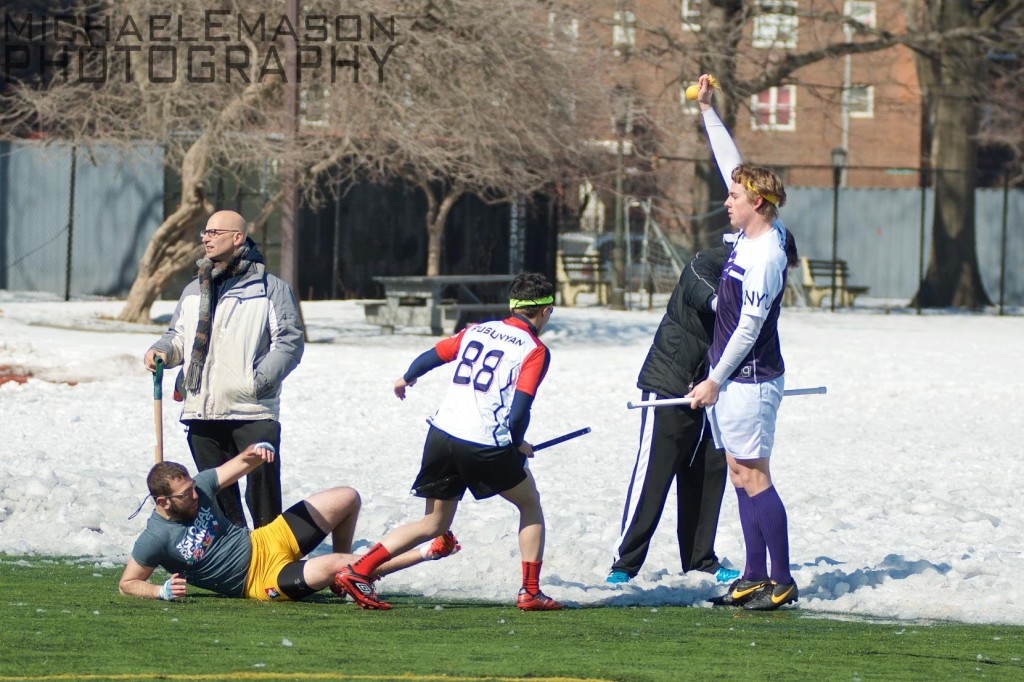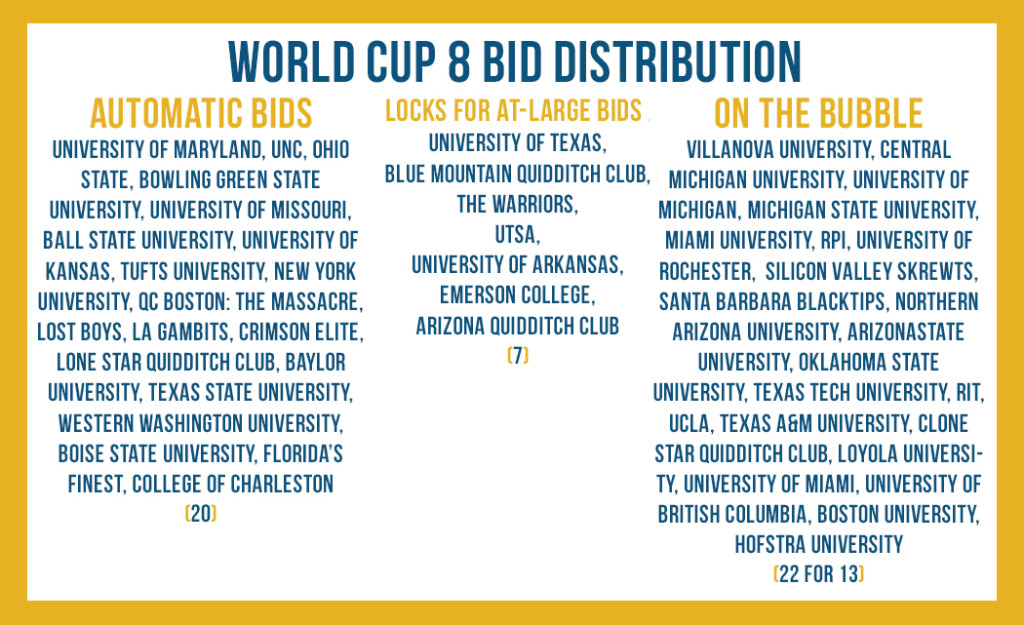- Rule, Britannia, no more?
- Unpopular Opinions: US Quadball Cup 2023
- Proven Contenders: University of Virginia
- Proven Contenders: Rutgers University
- Proven Contenders: University of Michigan
- Proven Contenders: Creighton University
- Different Perspectives: A Look Inside USA Ultimate
- Antwerp QC, Much of Belgian Core, Leaves Competitive Quidditch
At-Large Bids: An Alternative World Cup Proposal
- By Ethan Sturm
- Updated: March 18, 2015

Credit: Michael E. Mason
Regional season came to a close March 7 with the Northwest Regional Championship, and, with the exception of a Clint Dempsey sighting, the four-month slog across the country ended with a yawn. So what were the memorable takeaways from the seven-tournament marathon that ate up both the better part of the middle of the season and most teams’ travel budgets? There were six first-time winners, but the favorites took care of business.
The Eighth Man’s Oct. 21 poll–the last one before any regionals–successfully predicted all six ranked champions. UNC drummed up some excitement early, taking University of Maryland to overtime before falling to the Terrapins. But, since then, only two finals have been in snitch range, and both were decided by 60 points. The seven champions played a combined total of 10 snitch-range games at regionals. The seven runners-up have played the same amount, which comes out to an average of 1.5 snitch-range matches per team.
The once-great UCLA struggled in the West Regional but still qualified comfortably. College of Charleston made a Cinderella run in the South, knocking out University of Miami in the semifinals, but the Cougars will not go down in history as champions, falling to Florida’s Finest Quidditch Club on a suicide grab. In the Northeast, beating Syracuse University remained the gold standard for qualifying, and only five teams at the Southwest Regional Championship failed to qualify. In total, 22 teams with sub-.500 records are headed to World Cup.
The Swiss format of World Cup also has not done the humdrum nature of the spring season any favors. With no pot placements to compete for, teams either are not bothering to play official games or are going to them with trial or short rosters. New York University, the Northeast Regional runner-up, lost an official game to the 9-13, unqualified Philadelphia Honey Badgers, and no one blinked. Winter weather in the Northeast, Midwest and Mid-Atlantic has just been the icing on the cake, causing game and practice cancellations across these regions.

Credit: Michael E. Mason
USQ has finally done regional tournaments a favor by reducing the 2016 USQ Nationals field to 60 teams, putting more established programs on the bubble for World Cup qualification and increasing the stakes of those early Sunday qualification rounds. But it does not increase the relevance or stakes of the late rounds of the day, where a clear favorite can make all of Sunday afternoon pretty uneventful.
I know I have become the regionals pessimist this season, so instead of just being melancholy about the whole ordeal, I am going to attempt to be productive as well. Below, I will go through my current favorite fix for the USQ season’s format. Even if the entire plan isn’t implemented, perhaps we can find some concepts to apply going forward to make for a more interesting quidditch season.
Here is a proposal is for a 40-team World Cup with at-large bids, also known as the “Mitch Cavender Method.” The system comes with 20 automatic bids to World Cup, which are granted through regional championships, and 20 at-large bids. The four largest regional competitions each get three bids and the four smallest get two. Then, the other 20 teams are the next 20 most-deserving teams across the country as determined by a committee. These are the “at-large” teams.
How you go about forming a committee and having it determine the 20 at-large teams is the crux of this system. I would go about it by making a 24-person committee composed of three-person subcommittees from each region. All members of the committee would be required to watch a certain amount of video featuring the contending teams, with that amount being the majority if not all available footage of the teams. Starting the week after New Year’s Day, each sub-committee would be responsible for releasing regional rankings every two weeks. On “Selection Monday”–the day after the final regional–a team lower in a region’s final rankings cannot be picked over one higher. Then, once all the games have been played out, the 24 members get together and choose the 20 teams that will get to go to World Cup. World Cup format would shift back to pools of five teams, three of which advance to bracket play.
So what does this format do? First of all, it turns regional championships into marquee events. College of Charleston beating Miami would not just mean the Cougars get to go to finals, it would mean they would be headed to World Cup, while placing Miami firmly on the bubble for making it. It would be one of the biggest moments of the season. Every regional semifinal would become a World Cup qualifier. Tufts University coming back from 40 points with snitch on pitch to beat QC Boston: the Massacre? That is a qualifying game. NYU against The Warriors would have been a qualifying game between two teams with questionable resumes that would kill for an automatic spot. Baylor University beating University of Texas? Another qualifying game–though Texas would certainly end up with an at-large bid. And, do not forget, every finals match earns the winner more than bragging rights, it provides the team with a tangible benefit at World Cup.
This system would also beef up the spring season, especially for regions with fall regional championships. The Warriors, for example, hypothetically failing to qualify at their regional would now be incentivized to play games against the Midwest and Mid-Atlantic’s second tier to prove they are a step above. University of Rochester would need to attend tournaments to show the committee what its new roster can do. Blue Mountain Quidditch Club would have to play significantly more games to demonstrate its development. Arizona State University and Arizona Quidditch Club could end up playing an intense three-game set a week before Selection Monday to definitively prove who deserved to be third in the West rankings.

Credit: Monica Wheeler
It would also incentivize the entire community to increase the breadth and frequency of match film. Come Selection Monday, no one wants to be the team that is the enigma in the committee’s eyes, so instead of teams fighting to be the best at hiding their film, it will become a battle of who can get the most film public. No matter how you look at it, having an increased amount of film is a net gain for the sport.
For quidditch-obsessed people like me, it would also mark a return to the anticipation of the pool selection show. For years, the whole community has come together to enjoy the day the World Cup pools were revealed, with water-cooler talk everywhere about pools of death and which team got the best draw. But with 40-team flights and first-round matchups being the only thing revealed this year, it will not be the same. In this system, not only do we get the excitement of how the pools break down, but also the drama of which teams will go to World Cup and which will come up short.
Of course, any format is going to have its shortcomings, and the most glaring one in this case is that instead of determining the bids purely through competition and statistical rankings, we will be doing it in part by using the objective decision-making of a 24-person panel. Someone is going to be subjectively left out of the tournament, and that team is rightfully going to be upset about it.
But by opening the selection process to include subjectivity, it also allows for levels of accuracy that cannot be obtained by a single-elimination bracket and a computer program. A slow start to the season can skew a team’s ranking, but if it have tangibly improved, a human panel can see that. A committee can also correct for differences in the skills of regions that can only roughly be accounted for under the current bid-distribution method. There is no point in giving an atrocious team a spot at World Cup just because its region put just enough teams in the Round of 32 the season before, especially if a more deserving one is waiting in another region.
Another issue with this method is that it means nearly half the field of teams will not know they are World Cup-bound until a month before the tournament, creating flight ticket premiums and a short window for fundraising. While I admit the flight situation would not be ideal, it is already a reality facing all of the teams that had a spring regional this year. And as for fundraising, I stand firmly behind the belief that “we didn’t have enough time to fundraise for this tournament” is an invalid excuse. Fundraising efforts should be running full throttle all year, whether you know you are qualified for World Cup or not.
By this system, the field next season would be reduced from 60 teams to 40. However, this could easily be used with 60. You would just change the distribution to 32 automatic bids–four per region–and 28 at-larges. Personally, I see 40 teams as the more interesting and manageable tournament.
Just for fun, let us take a look at how the World Cup would have shaped up this season using this format. Below, I will list the teams that would be auto-qualified, the teams that would comfortably get an at-large bid and the bubble teams. The Midwest is given five automatic bids since it will be split into two regions next season.
This is an extremely interesting breakdown. The bubble is completely wide open and would lead to hours of conversations and, ideally, hours of games scheduled between these teams. This weekend’s Glass City Classic, which includes four bubble teams and a fifth team, Marquette University, which could still play its way onto the bubble, would go from meaningless in the grand scheme of the season to one of the most important tournaments of the year. A dull spring season would once again have lifeblood.
As with any format, this one has its holes, and I definitely have not put it through the ringer yet. But there is a lot to be said for it, and, going forward, it might be the season format that offers the most bang for our buck September through April. When NCAA football says “every game matters,” it is a hyperbole, but with the selection committee always watching, that would truly become the case in our sport.
What more could you really want for quidditch?
Related Posts
About Ethan Sturm
Ethan is the co-founder and former managerial editor and chief correspondent of The Eighth Man. When not talking quidditch, which is rare, he can be found drilling people's teeth and spending time with his elusive wife. He's also the worst.




